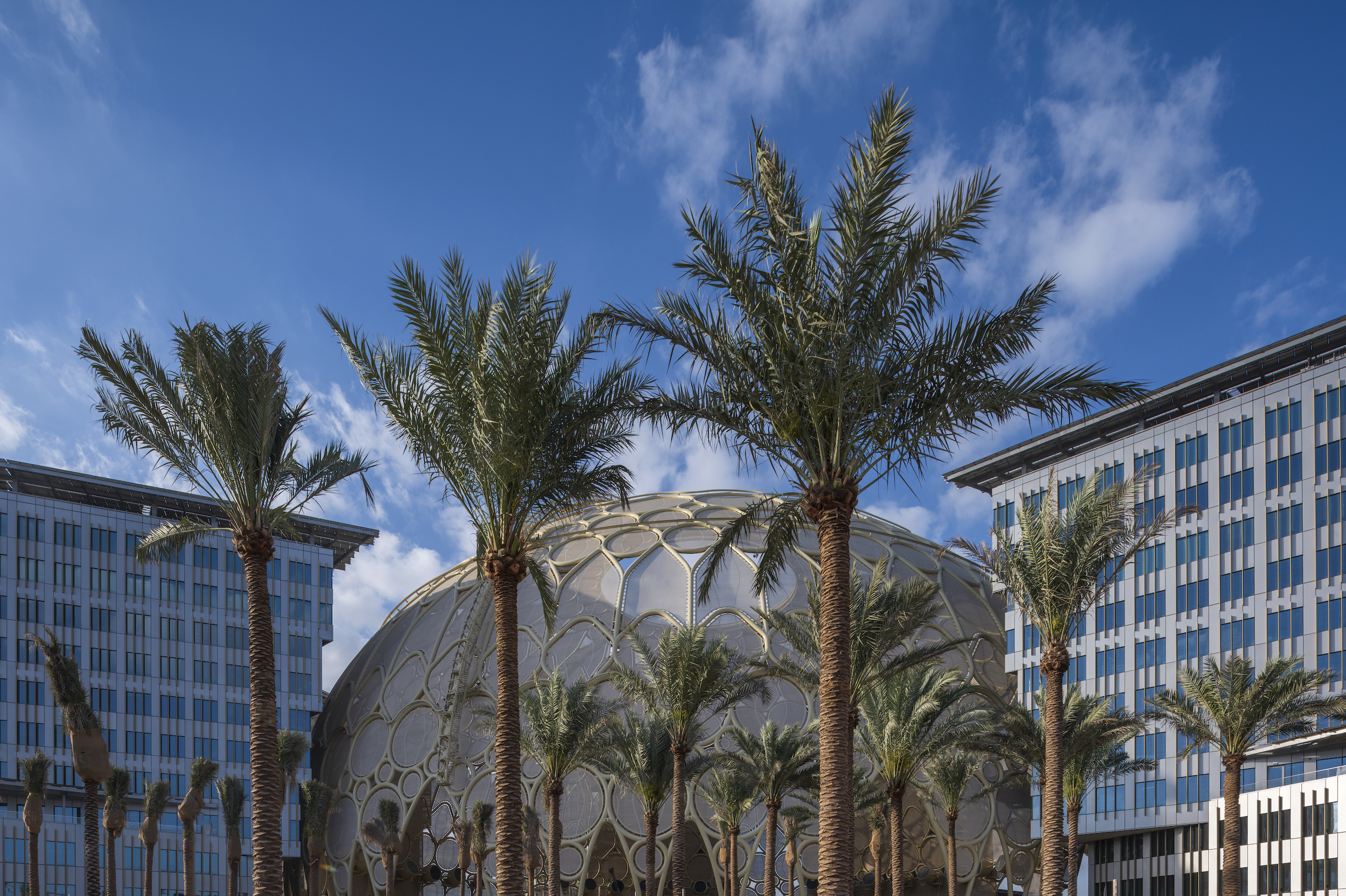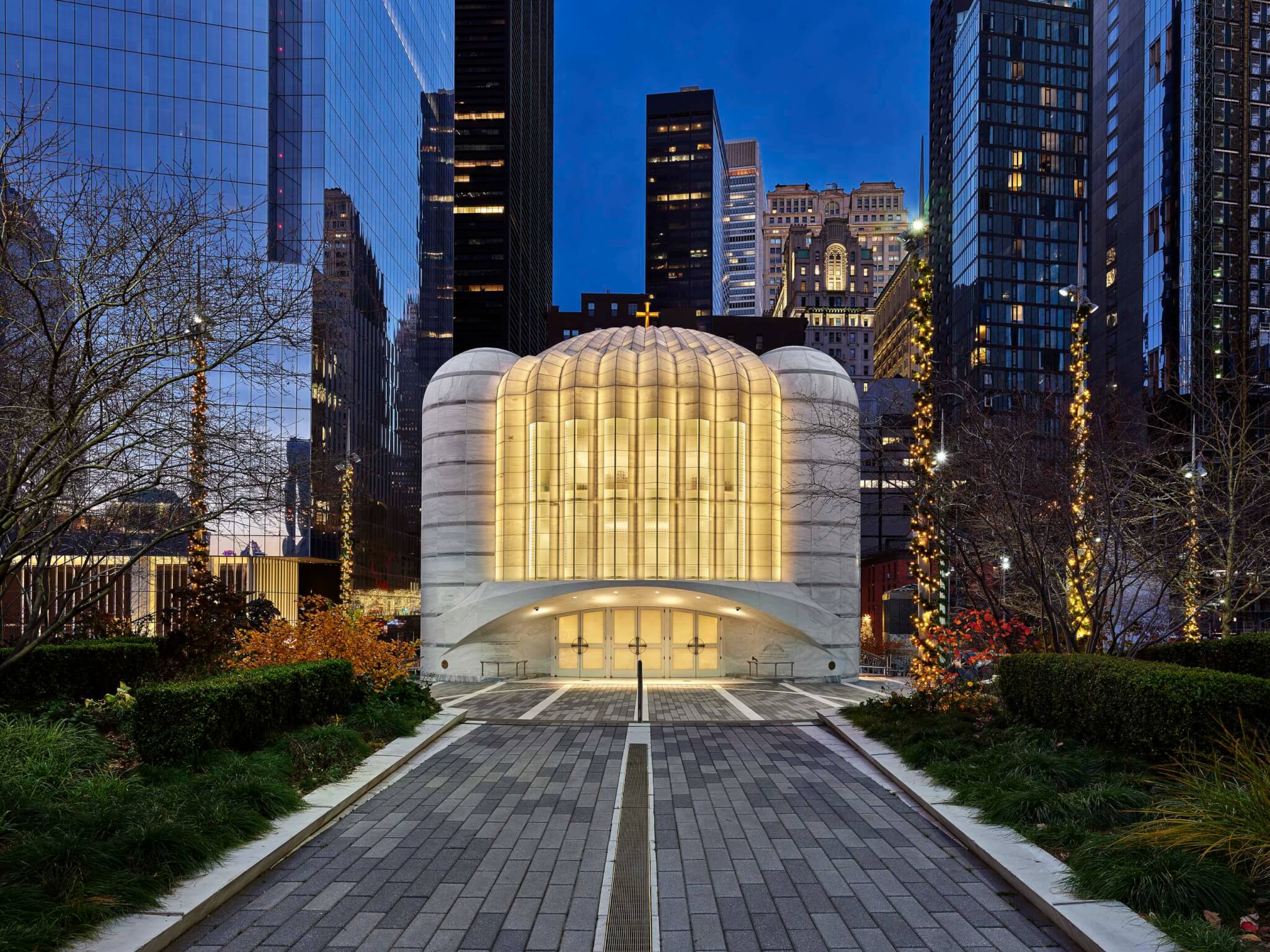Expo 2020 Dubai, the first non-specialized World’s Fair held in the Arab world and the first major Bureau International des Expositions (BIE) expo to be postponed, is now underway in the Persian Gulf-hugging emirate. Located in the south of Dubai near a border shared with Abu Dhabi, the 1,000-plus-acre Expo 2020 site has emerged from a sprawling stretch of barren desert as a self-contained, transit-linked mini-city master-planned by HOK with Arup and Populous and bookended by a trio of monumental carbon-fiber entry gates designed by Asif Khan.
Themed Connecting Minds, Creating the Future, the six-month global event with a $7 billion price tag formally kicked off late last week with an extravagant opening ceremony program at the Adrian Smith + Gordon Gill Architecture-designed Al Wasl Plaza dome (the world’s largest 360-degree project surface). The spectacle featured fireworks, attendant royalty, a clutch of celebrities, and performances by Andrea Bocelli, Ellie Goulding, and others. The entire event was available for viewing via a global live stream and, notably, was broadcast on the Nasdaq screen and Thomson Reuters display in Times Square for a full hour last Thursday afternoon, treating tourists to midday razzle-dazzle straight from the United Arab Emirates.

As for the pavilions, the UAE Pavilion, one of two designed by Spanish-Swiss architect Santiago Calatrava along with the Qatar Pavilion, is naturally the most prominently sited. Inspired by the form of a traditional Bedouin Tent and ringed by moveable, photovoltaic panel-lined exterior “wings” that suggest a falcon, the 161,000-square-foot structure anchors Al Wasl Plaza in lieu of being located in one of three thematic districts—Sustainability, Mobility, Opportunity—like the other national pavilions.
Key features of the LEED Platinum-certified UAE Pavilion, which Calatrava described as being “rooted in UAE’s local rich history and cultural heritage,” include an immersive, multi-sensory experience that “guides visitors through the ‘Land of Dreamers Who Do;” a subterranean garden that “offers a cool and tranquil environment with large water pools and trees naturally cooling the air, creating shade, and reducing reflected heat;” a spherical, 200-person capacity auditorium, and a lushly-planted landscape featuring thousands of plants from a dozen species, many of them native, along with well as over 80 trees, with roughly 45 of the them “holding cultural importance for the UAE.” As further detailed by Calatrava International in a press release, the overall layout of the sprawling pavilion site at Al Wasl Plaza is inspired by the image of the Aton Sun, “providing opportunities for visitors to approach the pavilion from all angles and to allow the surrounding areas of the pavilion to gently integrate with its immediate surroundings.”
As Expo 2020 Dubai continues to get underway in the coming weeks, AN will take a closer look at a handful of the other national pavilions, including the Woods Bagot-designed, UAE-funded United States Pavilion (the Australia-founded firm replaced Colorado-based Fentress Architects) and Es Devlin’s mass timber United Kingdom Pavilion, located in the Mobility and Opportunity districts, respectively. In total, 190 countries are taking part in Expo 2020 and, in a World’s Fair first, all participants will present individual pavilions, although they vary from modest installations to full-blown buildings. In addition to the national pavilions, large themed pavilions also anchor each district with Grimshaw Architects, Foster + Partners, and AGi, a practice with offices in Kuwait and Madrid, leading the charge in Mobility, Sustainability, and Opportunity zones, respectively.

Somewhat of a last-minute entry, Dubai was selected to host Expo 2020 via BIE voting in 2013, beating out bids from Yekaterinburg, Russia; Izmir, Turkey, and São Paulo, Brazil. Osaka, Japan, was selected by the BIE in 2018 to host Expo 2025.
In addition to being hampered by the COVID-19 pandemic, Expo 2020 has been dogged by reports of construction worker fatalities, including some from COVID, as well as a spate of serious injuries. More broadly there is ongoing scrutiny over the treatment of the meagerly paid migrant workers, largely from Africa, in the UAE. In September, the European Parliament implored member nations not to take part in Expo 2020 due to what it called “inhumane practices against foreign workers” and larger human rights abuses.
In total, workers spent a collective 247 million work hours constructing the built-from-scratch exposition city-site. At the top of the fair, Expo 2020 organizers unveiled a “striking and emotive” monolithic stone monument designed by Khan that pays tribute to the mega-event’s 200,000-person-plus workforce. Organizers have released statements countering the backlash and have been quick to tout a six-pillar “Better Together” strategy that promotes a “positive, values-driven approach to health and safety and worker welfare.”
To enter the Expo 2020 site, all visitors must present a negative PCR test or proof of COVID-19 vaccination. Over 25 million people are expected to attend the event by the time it closes in March of next year.











